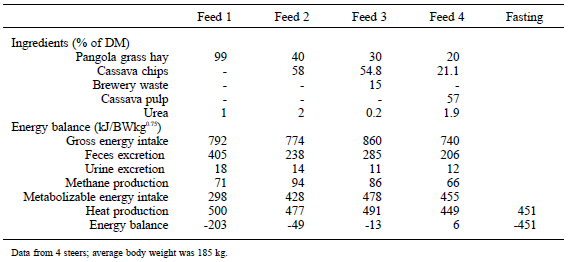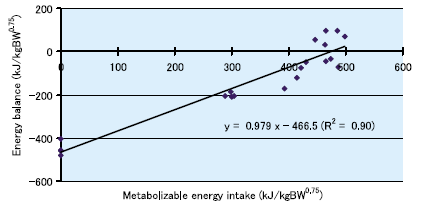Metabolizable energy requirement for maintenance of native beef cattle in northeast Thailand
Description
In Thailand, the nutrient requirements of cattle are based on information gathered from countries located in temperate zones. Since the breed of cattle, climatic conditions, and available feed resources in Thailand differ from those in temperate zones, the nutrient requirements of cattle in Thailand may not be the same as those recommended. However, the energy balance in cattle has been measured to a limited extent. To be able to study energy metabolism in cattle, we have developed a respiration trial system with a ventilated hood at Khon Kaen Animal Nutrition Research and Development Center, Khon Kaen, Thailand.
Metabolizable energy (ME) requirement for maintenance was estimated by regression analysis from the results of 16 energy balance trials using four mature Thai native steers. Their average body weight (BW) was 185 (from 175 to 210) kg and age in months was 36. Steers were fed at 1.5% of BW on a dry matter (DM) basis twice a day. Crude protein content in the experimental diet was 7.1 to 7.8% on a DM basis.
Energy balance was negative along with nutrient contents in the feed when the feeding level was set at 1.5% of BW on a DM basis (Table 1). Average ambient temperature was 28.3 (minimum 15.2, maximum 40.0) degrees Celsius and humidity was 54.6% (minimum 10.0, maximum 95.0%) during the experiments.
The ME requirement for maintenance was estimated as 476.6 kJ/kgBW0.75 from all the data for ME intake and balance by Thai native steers (Fig. 1). This value is the same as for Japanese black steers as listed in the Japanese feeding standard (470.3 kJ/kgBW0.75). Furthermore, it is nearly half the value of several kinds of beef cattle in Europe and the United States (401.7 to 543.9 kJ/kgBW0.75) as listed in the National Research Council feeding standard.
The ME requirement for maintenance in Thai native steers is useful information for calculating the daily amount of feed and should be utilized as basic data for feeding standards in the Indochinese peninsula. To be able to promote more efficient use of local feed resources, it is necessary to be aware of not only the animals’ requirements but also of the nutrient content of their feed. Furthermore, since there are many kinds of native cattle in each area and they may have different characteristics, we will continue to collect more data on requirements using indigenous cattle in many areas in Thailand.
Figure, table
-
Table 1. Feed formulation and results of energy balance trial with Thai native steers.
-
Fig. 1. Relationship between metabolizable energy intake and energy balance in Thai native steers.
- Affiliation
-
Japan International Research Center for Agricultural Sciences Animal Production and Grassland Division
- Classification
-
Technical A
- Term of research
-
FY2006(FY2006~2011)
- Responsible researcher
-
NISHIDA Takehiro ( Animal Production and Grassland Division )
NITIPOT Peerapot ( Khon Kaen University )
CHAOKAUR Anan ( Khon Kaen University )
Sommart Kritapon ( Khon Kaen University )
ORCID ID0000-0002-6947-412XPHAOWPHAISAL Ittiphon ( Khon Kaen Animal Nutrition Research and Development Center )
PHOLSEN Pimpaporn ( Khon Kaen Animal Nutrition Research and Development Center )
NARMSILEE Rumphrai ( Khon Kaen Animal Nutrition Research and Development Center )
INDRAMANEE Somchit ( Khon Kaen Animal Nutrition Research and Development Center )
- ほか
- Japanese PDF


